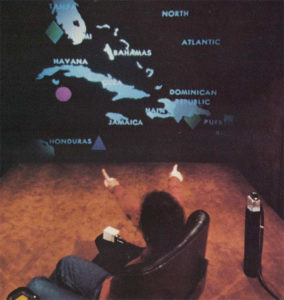
Et la dictée fut
Entretien avec Donald Barabé, président de l’Ordre des traducteurs, terminologues et interprètes agréés du Québec (OTTIAQ)
Read in English: Along Came Dictation
Depuis des millénaires, les êtres humains se servent d’outils, entre autres pour allumer du feu, pour chasser, pour se nourrir, pour bâtir, pour écrire et pour communiquer. En traduction, les historiens affirment que la traduction écrite aurait vu le jour parallèlement à la parution des alphabets, ainsi que des systèmes et des outils d’écriture. Au cours de l’histoire, les langagiers ont adopté divers outils au gré des avancées constantes dans les sciences et les technologies : depuis les outils de gravure jusqu’aux machines à écrire et ordinateurs personnels, ces derniers constituant aujourd’hui l’outil de travail par défaut des traducteurs professionnels.

« En traduction, où l’offre professionnelle ne suffit pas à la demande, les traducteurs et leurs employeurs auraient tout intérêt à utiliser la dictée. » – D. Barabé
Or, depuis plus d’un demi-siècle, les traducteurs ont la possibilité de dicter leurs textes plutôt que de les taper. Pourtant, la traduction dictée (TD) et les outils de dictée, très courants dans le milieu de la traduction des années 1960 et 1970, sont souvent vus aujourd’hui avec méfiance par les traducteurs en exercice et par les écoles et les services de traduction. La grande majorité des traducteurs s’en tient aux méthodes courantes, à savoir la traduction saisie à l’ordinateur et à l’aide d’outils d’aide à la traduction, parce qu’ils n’ont pas jugé bon de faire l’essai de la TD. Toutefois, un nombre non négligeable de traducteurs dans le monde entier dictent leurs traductions, soit au dictaphone, en collaboration avec un copiste qui transcrit la traduction dictée enregistrée, soit à l’aide d’un logiciel de reconnaissance vocale prenant en charge la transcription de façon automatique.

« Avec la dictée, on a tout à gagner. » – D. Barabé
J’ai eu la chance de rencontrer plusieurs traducteurs au Canada, comme à l’étranger, qui ont dicté pendant des décennies, ou qui dictent encore. On les connait dans le milieu, en français, sous le nom de « dicteurs ». L’un de ces dicteurs qui a bien connu la profession de traducteur avant l’ère des ordinateurs personnels est Donald Barabé, actuel président de l’Ordre des traducteurs, terminologues et interprètes agréés du Québec (OTTIAQ) et ancien vice-président, Services professionnels, du Bureau de la traduction du gouvernement du Canada.
J’ai pu m’entretenir avec M. Barabé afin d’en apprendre davantage sur cette technique, qui constitue depuis plusieurs années le cœur de ma recherche traductologique et de ma pratique professionnelle, ainsi que des activités de R et D de mon entreprise. M. Barabé, comme tout autre dicteur contemporain que j’ai rencontré au fil des ans, semble heureux d’avoir connu l’ère de la TD.
Julian Zapata : Merci, M. Barabé, de m’accorder cet entretien.
Donald Barabé : C’est un plaisir, surtout s’il s’agit de ressusciter la traduction dictée!
JZ : Comment vous êtes-vous initié à la dictée ?
DB : J’ai commencé à dicter tout de suite après mes études universitaires vers la fin des années 1970. Mon employeur, le Bureau de la traduction, m’a assigné un poste de travail où se trouvaient une machine à écrire – les machines de traitement de textes étaient réservées aux copistes à l’époque – et un dictaphone. Mon superviseur m’a bien fait comprendre que la machine à écrire ne devait servir qu’aux textes courts, très courts (moins de 50 mots). Il a pris quelques minutes pour me montrer le fonctionnement du dictaphone et m’a dit de me lancer. Les copistes m’ont aussi donné des trucs, par exemple pour la traduction de tableaux. Comme tout le monde dictait déjà, je me suis mis moi aussi à dicter. En fait, la dictée était déjà la méthode de traduction par défaut dans le milieu depuis des années, surtout dans le cas des salariés.
JZ : Aviez-vous été formé à faire de la dictée à l’université ?
DB : Cela ne faisait pas partie du cursus. D’ailleurs, je ne pense pas qu’il y ait eu des cours de traduction dictée au Canada. Il y a bien eu quelques exercices de traduction à vue dans les cours de traduction ou d’interprétation, bien que cela ne soit pas un préalable essentiel à la dictée. Je ne pense pas non plus qu’il faille posséder plusieurs années d’expérience en traduction écrite pour se mettre à dicter. C’est une compétence que l’on peut acquérir soi-même par la pratique. Il suffit de savoir traduire, tout simplement.
JZ : Pensez-vous que la dictée est possible dans toutes les combinaisons de langues et pour traduire tout genre de textes, peu importe le niveau de difficulté de ces derniers ?
DB : Ma langue maternelle est le français, et j’ai surtout traduit de l’anglais vers le français. Mais je ne pense pas qu’il soit impossible ou plus difficile de dicter dans une combinaison de langues en particulier. Si on peut traduire par écrit, on peut le faire oralement. Naturellement, si votre accent en langue B ou C est trop prononcé, il se peut que le copiste ou le logiciel de reconnaissance vocale ait de la difficulté à vous comprendre. Je ne crois pas non plus qu’il y ait des textes plus difficiles à dicter pour ce qui est du sujet et de la terminologie. C’est une autre histoire pour le formatage. À l’époque, si on traduisait un texte avec un tableau, par exemple, il fallait numéroter chacun de ses éléments et en dicter la traduction. Le copiste reproduisait le tableau original et y insérait les éléments dictés. Ayant peu d’expérience de la dictée par reconnaissance vocale, je ne saurais me prononcer sur sa facilité d’utilisation – ou non – pour les textes à mise en page complexe.
JZ : Pensez-vous que la raison principale du recul de la TD a été l’arrivée massive des ordinateurs personnels dans les années 1980 ?
DB : Il est clair que les employeurs dans tous les domaines d’activité et pas seulement en traduction ont vu en l’avènement de l’ordinateur personnel l’occasion de faire l’économie du salaire des secrétaires, assistants, adjoints et copistes. À mes yeux, cela a été une erreur, car ils ont confié à leurs autres employés, souvent des professionnels, des tâches pour lesquelles ils ne possèdent pas d’expertise, perdant ainsi de vue que le temps que ces employés et professionnels passent à la mise en page et au formatage des textes, ils ne le consacrent pas à leurs fonctions principales, celles pour lesquelles ils ont précisément été engagés.
En traduction, où l’offre professionnelle ne suffit pas à la demande, les traducteurs et leurs employeurs auraient tout intérêt à utiliser la dictée. En fait, en traduction professionnelle, nous aurions grand intérêt à déléguer toutes les fonctions sauf les deux qui sont l’exclusivité des professionnels : le transfert linguistique et son contrôle. Toutes les autres fonctions, à savoir les recherches documentaires, les recherches terminologiques, la mise en page et le formatage, devraient être confiées à un paralangagier. Le temps passé par un traducteur professionnel à ces autres fonctions est du temps qu’il ne consacre pas à sa responsabilité première – la traduction – dont il est le seul à posséder l’expertise. Cela nuit grandement à sa productivité.
JZ : Pensez-vous que certains dicteurs n’ont jamais appris à saisir à la machine ou à l’ordinateur ?
DB : Je crois que tous les traducteurs savent utiliser un ordinateur, même ceux qui n’ont pas cessé de dicter. Et il y en a. Ceux-là n’ont jamais fait de pas en arrière pour ce qui est du rendement.
JZ : On parle d’une productivité supérieure de quel ordre par rapport à celle des traducteurs qui ont passé à la traduction saisie à l’ordinateur ?
DB : Certains facteurs entrent en jeu. Cela peut sembler paradoxal à première vue, mais l’ordinateur a rendu la mise en page et le formatage à la fois plus simples et plus complexes. Plus simples parce qu’ils ne sont plus l’apanage des typographes et qu’ils peuvent être faits par tous. Plus complexes parce qu’ils permettent de réunir dans un même document plusieurs éléments disparates (texte, tableaux, graphiques, images, animations, etc.), ce qu’il n’est pas donné à tous de réaliser efficacement. On n’a qu’à penser aux présentations PowerPoint. Bien qu’un traducteur professionnel puisse développer une certaine aisance dans le maniement des logiciels de traitement de textes, il n’en demeure pas moins que, lorsqu’il « manipule » les textes et leur format, il ne traduit pas. Son rendement traductionnel et sa rentabilité s’en trouvent affectés. Sans compter que, même avec le doigté dactylographique, taper un texte sera toujours plus long que de le dicter.
JZ : Que conseillez-vous lorsque des prétraductions sont fournies, ce qui est de plus en plus le cas ?
DB : Il peut être plus efficace et plus rapide de dicter le tout que de remanier le texte soi-même.
JZ : Selon vous, la rentabilité est-elle le principal avantage de la dictée ?
DB : La rentabilité est certes un avantage, mais ce n’est pas le seul. L’ergonomie est également importante. Rares sont les traducteurs qui maîtrisent le doigté dactylographique, ce qui les oblige à faire toutes sortes de contorsions pouvant entrainer des lésions professionnelles. Sans parler de la lenteur que cela cause et qui affecte la rentabilité. La dictée peut se faire debout, en marchant même.
Un autre avantage important est sans doute l’amélioration de la qualité. En effet, la dictée permet d’entendre la phrase prononcée et d’en évaluer l’idiotisme. Elle procure également un recul, ne serait-ce que de quelques instants avec la reconnaissance vocale, qui donne l’occasion de voir la traduction d’un œil neuf. En fait, j’oserais dire que la dictée n’a que des avantages, d’autant plus que, avec la reconnaissance vocale d’aujourd’hui, on économise le coût de la transcription et on réduit le délai de la transcription par un tiers.
JZ : Même si la reconnaissance vocale fait encore quelques erreurs ?
DB : Les copistes humains font eux aussi des erreurs. Il en va de même des traducteurs. Le défi est de dicter dans des bureaux à aire ouverte ou dans des cubicules.
JZ : En reconnaissance vocale, on a fait des bonds importants en précision dans des milieux ayant des bruits ambiants ou pour permettre de parler assez doucement au système, presque en chuchotant.
DB : Si tel est le cas, cela représente un bond spectaculaire. Il ne faut pas perdre de vue que les copistes transcrivaient parfois mal parce qu’ils ne comprenaient pas ce qui avait été dit ou qu’ils méconnaissaient certains mots.
JZ : Pensez-vous que les dicteurs, en raison de leur capacité à traduire à vue, peuvent aussi exercer le métier d’interprètes ?
DB : Je ne suis pas certain qu’on puisse associer traduction dictée et traduction à vue. Cette dernière est faite « à la volée », ce qui n’est généralement pas le cas de la première. Le dicteur compose chaque phrase dans sa tête, puis la dicte. Le traducteur qui tape ses traductions peut faire de même. Il peut aussi se lancer directement et ajuster sa phrase une ou plusieurs fois. Il y perdra en efficacité, donc en rentabilité. Pour revenir à la question, la traduction dictée peut jusqu’à un certain point aider à l’interprétation consécutive, mais je doute qu’il en soit de même pour la simultanée.
JZ : Les dicteurs se sont-ils bien adaptés aux évolutions des appareils de dictée au fil du temps ?
DB : Je dirais que les dicteurs qui recourent à la transcription humaine se sont fort bien adaptés à l’évolution du dictaphone. En ce qui concerne ceux qui ont fait l’essai de la reconnaissance vocale, cela varie. Certains s’y sont très bien adaptés, d’autres moins. Comme je l’ai mentionné, cette technologie a beaucoup évolué ces dernières années. Je crois que tous les traducteurs auraient intérêt à l’essayer aujourd’hui.
JZ : Et qu’en est-il de la recherche informationnelle?
DB : Je suis d’avis que la reconnaissance vocale deviendra de plus en plus le mode privilégié d’interaction. Pour s’en convaincre, on n’a qu’à voir la popularité croissante des assistants personnels tel Alexa.
JZ : Existe-il des facteurs de fatigue inhérents à la traduction dictée? Peut-on dicter 7 ou 8 heures par jour comme on fait aujourd’hui traditionnellement avec l’ordinateur à clavier?
DB : À moins d’éprouver des difficultés d’élocution, il n’y a aucune contre-indication à la dictée. Il ne faut pas perdre de vue que le temps nécessaire pour dicter une traduction est considérablement moindre que celui requis pour traduire. J’oserais même avancer, selon mon expérience, qu’en dictée on est moins fatigué, physiquement ou mentalement, au terme de sa journée de travail.
JZ : Quels défis prévoyez-vous donc pour ressusciter la dictée dans cette ère de traductique, de post-édition et de traduction automatique ?
DB : Je pense que, avec l’omniprésence des appareils mobiles et en raison des grandes avancées en matière de reconnaissance vocale et en technologies infonuagiques, on peut envisager une intégration graduelle de la traduction dictée interactive dans les grands services de traduction et aussi aux postes de travail des pigistes. Comme je l’ai dit plus haut : avec la dictée, on a tout à gagner.
« [L]a reconnaisance vocale […] a beaucoup évolué ces dernières années. Je crois que tous les traducteurs auraient intérêt à l’essayer aujourd’hui. » – D. Barabé








